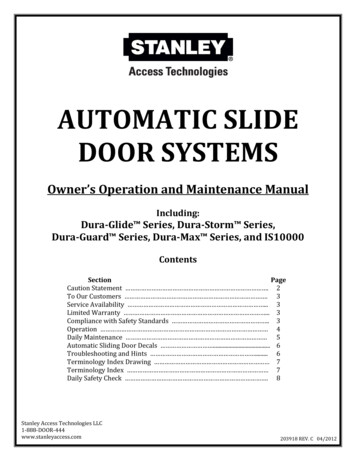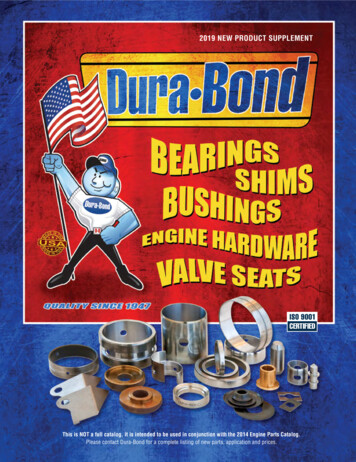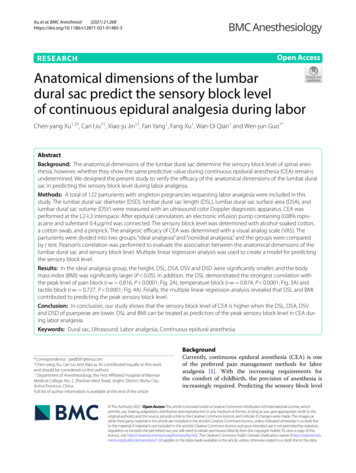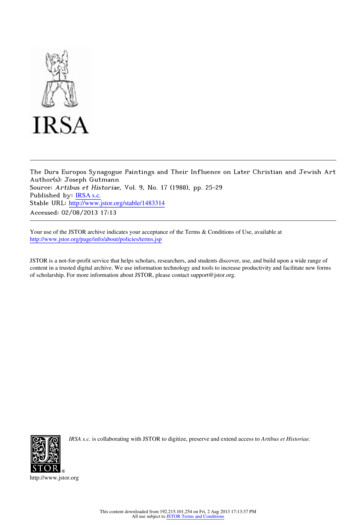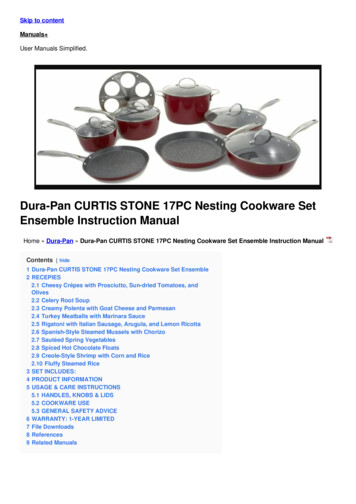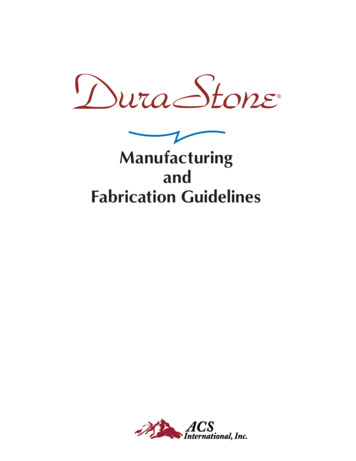
Transcription
Dura Stone CWdk\WYjkh d]WdZ WXh YWj ed k Z[b d[i
Table of ContentsChapter One: Introduction to Dura Stone .3 Dura Stone applications Colors (cross reference charts) Custom colorsChapter Two: Preparation.4 Mold surfaces Resins Mixers Set-up Gel test proceduresChapter Three: Mixing Instructions.5 Equipment requirements Catalyst chart Procedure Weight requirements Mixing PouringChapter Four: Casting.7 Vibrating Curing Casting record keepingChapter Five: Fabrication.8 Handling and safety Abrasive planning (belt sanding procedure) Machining seams Standard butt seams Platejoiner method, Single pass same cutting Wavy edge bit method Fusing with Acrybond Solid Surface Adhesive Working with Acrybond Temperature vs. gel time Material preparation Seams and build-ups Drop edges Procedure for laminating build-ups Applying build-upChapter Six: Installation.13 Runner method Tips Vertical surfaces installationChapter Seven: Finishing.15 Surface inlay techniques for poured product Color inlay Finish sandingChapter Eight: Care and Maintenance.16 Repairs and patchingChapter Nine: Trouble Shooting.18 Inadequate seamsInstallation problemsAppendix.20 Catalyst/resin charts Glossary of terms Dura Stone to Acrybond color cross reference chartACS International, Inc. 4775 S. Third Avenue, Tucson, AZ 85714 520-889-1933 Fax: 520-889-6782
Dura Stone combines the look of natural stone with the strength ofman-made materials. Comprised of a filler base of 100% aluminatri-hydrate, Dura Stone offers excellent stain resistance and toolingcharacteristics. In addition, when exposed to high levels of heat,alumina tri-hydrates release water—making Dura Stone a fireresistant product.Designed especially for counter top applications, Dura Stone is alsowell suited for many other uses such as wall panels, decorative trim,and tub and shower surrounds. For ease-of-use, Dura Stone can becut and machined with conventional wood working tools. A varietyof finishes can be obtained from matte to a luxurious high glossusing orbital sanders.Dura Stone Standard Color SelectionDura Stone is available in a variety of premium large chip andstandard chip colors.Color NameApple Wood*Arctic MelangeAuroraAutumn*AvalancheAztec Gold*BasilBlack Forest*Cape CodCashmereCherry WoodClear CreekClove PepperCoral ReefCoronaCountry Side*Dove Gray *English ToffeeEgyptian Sand*EverestFlannel*French Burgundy*FrostGold RushHearthHunter Green*Kilamanjaro*LondonMahogany*Magna Platinum*Magna Rosetta*Magna SaharaMagna SavannahMidnight*Mocha*Pepper Ivory*Rocky Mountain*Ruby*Chapter 1Color ndstoneSea ShellSedonaSheer LinenSierra Sky*Silver ExpressionsSpiceSpring RainSterling*White SilkWinter 05DGLC870DG020DG606DS010*These Dura Stone colors contain no (or very little) pigment. Theymay be mixed with marble resin and used behind gel coat to achievegranite looking product. An advantage to casting Dura Stone in thismethod is that a fabricator does not have to worry about porosity,expensive vacuum mixers and other solid surface equipment. Thedisadvantage is that Dura Stone is designed as a solid surface product,and is intended to be sanded to expose cross sections of the chips inthe product. Thus, achieving the appearance represented by samplesquares or brochures.**Please note that color numbers containing an “LC” are thepremium, large chip selections.Dura Stone Custom ColorsCustom colors are available by special order. Please contact ACSdirectly at 520-889-1933 or toll free 800-669-9214.ACS International, Inc.Page 3Introduction to Dura Stone Chapter One: Introduction to Dura Stone
PreparationChapter Two: PreparationMold SurfacesThe following materials work well as mold surfaces: Fiber glass Stainless steel Aluminum Laminate Tempered glass Cold rolled steelSanding the finished product after de-molding is recommendedfor counter top applications regardless of the mold surface used.Therefore, counter top molds may utilize a wide variety of texturessince the surface appearance of the finished part will be determinedby the type of finish applied during fabrication. See chapter sevenfor more detailed finishing information.ResinsMost resin manufacturers are producing resins recommended for usewith non-gel coated applications. After testing a variety of differentresin types, the following conclusions have been reached regardingfactors contributing to optimum results for Dura Stone. Rememberthat some resins require a post cure in order to achieve a hard stainresistant surface.A few tips to remember when selecting a resin are:1. The resin should have good color consistency. A clear resin ispreferable for the solid color Dura Stone so that the resin tintdoes not influence the color of the finished part. Typically, anon-clear resin may cause the white colors to have a shade ofpink, brown, or green. With the granite Dura Stone this slighttint is usually not noticeable.2. A thin (600 cps to 800 cps) resin has the best air releaseproperties and wets out the filler quicker.3. Gel time is important when considering a resin. A preferredgel time should be under 30 minutes. You will find that theclear resins will gel slower. The reason they are clear is due tothe lack of promoter in the resin. So there is somewhat of atrade off between gel time and clarity.4. BPO catalyst system resins will work with Dura Stone. Beaware that BPO promoted resins will yellow quickly whenexposed to the weather and will yellow faster than MEKP resinsystems in indoor applications. Contact your resin supplierregarding application information.MixersThe use of a vacuum mixer is highly recommended when mixingsolid surface material. It is possible to mix Dura Stone without avacuum mixer, however optimal results will not be obtained.SetupMake sure the entire mold surface is waxed evenly. Release lines willresult from areas of the part that stick to the mold. Also, allow roomfor shrinkage, which is usually 1/16” to 1/8” per linear foot, but willvary depending on resin used and initiator levels.Page 4ACS International, Inc.Chapter 2
Cast a Pyrex dish in the same conditions as production. Forbest results the test pour should be the same thickness as normalproduction parts.7. Observe the test pour material and record the time elapsed formaterial to gel. The proper amount of catalyst will yield a 20minute gel time.8. Sand the mold side as would be done duringproduction.Observethefollowing:Test 1: Is the sanded area showing chip dispersal as desired?Test 2: Does the sanded area have the desired background color?Test3:Cutthesampleinhalf.Does the chip show to be evenly dispersedfrom top to bottom throughout the sample?Test 4: If not, warping may occur during production. If anyof these tests do not show color, chip placementor does show other problems, adjust initial ratiosand/or call ACS for technical assistance at 800 669-9214. 6.Gel Test ProceduresA gel test should be performed at the beginning of each day to determine the proper catalyst level that will produce a 20 minute geltime in the poured solid surface product. A separate test should beperformed for solid and granite perature and humidity. When a change in temperature occurs, anew gel test should be performed to establish a new catalyst benchmark.This test is also good to check for chip settling as large chip colorsfall if resin ratio is too high. Once a set of benchmarks are established a chart may be created for future reference.#ATALYST #HART CC S OUNCES OF RESIN Determining Weight RequirementsOnce the percentage of catalyst (see paragraphbelow on Dura Stone Material Calculator) is determined, the drymaterial required for mixing can be weighed out. At ½” thickness,a square foot of material weighs about four pounds and weighs sixGel Time Test ProcedureEquipment Required:1. Safety glasses and protective gloves shouldbe worn when working with chemicals.2. Note pad—for casting record keeping, seechapter four.3. Thermometer4. Accurate ounce/gram scale5. Stirring stick (tongue depressor)6. Timer7. 4x4 inch pyrex baking dish8. 32 oz mixing cup9. Syringe (cc) or accurate measuring cup10. Accurate pound scale Dura Stone Material CalculatorSee appendix for an expanded catalyst chart as well asa resin ratio chart.Testing Procedure1. Record ambient room temperature, resintemperature and filler temperature onnote pad for future reference.2. Weigh-out Dura Stone, Resin and catalyst at the same ratios as intended for production run.3. Add catalyst to mix, 2% in cooler conditions(temperatures below 77o F), 1% in warmconditions (temperatures above 80o F).NOTE: Some resins require greateramounts of catalyst. Use manufacturersrecommendations.4. Record the time that the catalyst was added on the designatednote pad.5. Add filler and stir (8 oz for granite and 10 oz for solid colorfiller).Chapter 3pounds at ¾” thickness. With this information, the amount of material needed can be calculated. The resin-to-filler ratio will varydepending on the viscosity of the resin used.ACS International, Inc.Page 5Mixing InstructionsChapter Three: Mixing Instructions
Mixing InstructionsA good rule of thumb is 40% resin and 60% filler by weight with avacuum mixer. Without a vacuum mixer, a 50% resins to 50% fillerratio is recommended for small chip products (not recommendedfor large chip products). Therefore, using a ½” thick panel as an example, approximately 2.4 pounds to filler per square foot is requiredwith 1.6 pounds of resin. A 50% ratio will also work and may savemoney in instances where the cost of resin is lower than the cost offiller.ness on the mold with a trowel. Do not vibrate the mold until theentire surface is completely covered over. This will eliminate anycasting lines.It is good practice not to scrape the material from the mixing bladesinto the mix pot before pouring . There may be undercatalyzed material trapped on the back side of mix blades.It is very easy to get an uneven thickness if you do not distribute thematrix carefully. Vibration while pouring is not recommended, butmay help even-out the material after it has been completely poured.Resin should not separate out of the mix with minimal vibrating (30seconds to one minute).The formula for determining total weight is:Sq. Ft x 4 Total mix weight for ½” thicknessSq. Ft x 6 Total mix weight for ¾” thicknessTotal mix weight x 0.40 Resin weight at 40%Total mix weight x 0.60 Filler weight at 60%Remember that the percentage of resin to filler needs to remain constant in order to assure a consistent color match.Dura Stone Material Calculator: ACS offers an easy to use worksheet that allows fabricator to plug-in the dimensions and resin tofiller requirements and easily obtain the correct resin, catalyst andfiller portions needed. The worksheet is available in MS Excel available on our web site. Please contact ACS at sales@acstone.com orcall 520-889-1933 if you are unable to access the web.MixingA single mixing time is impossible to predict due to the variety ofmixers on the market today. Some mixers may appear to be identical, however one may spin 1 3 slower, thereby requiring 50% longermixing time to achieve the same results. However, there are somesimple guidelines to follow.Dura Stone should be mixed for a minimum of fifteen minutesbefore adding the catalyst. Mix for an additional five minutes after adding catalyst. When opening the vacuum mixer to add thecatalyst, it is important to scrape the back sides of the blades witha trowel to remove under mixed material, trapped in the vortex ofthe paddle.The small particles in the matrix often tend to form lumps that cantake some time to disperse in the low shear mixer. These lumps maybe impossible to notice with a simple visual inspection of the matrixwhile it is in the mixer. You may have to dip a trowel in the matrixand visually examine the material closely to see the smaller lumps.If you are experiencing problems with undispersed pigment in solidcolors, you may have to increase mixer shear. To help increase shearon a low shear mixer, retain/remove approximately 25% of the resinfrom the mix for the first 15 minutes of mixing. The thicker mix willincrease the shear and tearing action of the mixing matrix, aidingsignificantly in pigment particle breakup.ONLY after there are no visible lumps in the mix is the catalystadded. Then, blend catalyst in thoroughly (five minutes minimum)and pour.PouringPour material in an even pattern across the mold. Make sure yourmold surface is level and that material is distributed in an even thickPage 6ACS International, Inc.Chapter 3
CastingChapter Four: CastingVibratingWhen using low viscosity densified resins, vibrating time should bekept to a minimum. About thirty seconds is sufficient. The graniteDura Stone colors may form a resin film on the surface of the partdue to over vibrating which allows the granite chips to sink. Thisfilm can be eliminated by closely monitoring vibrating time.CuringGel time should be 20 to 30 minutes. Most resins require a postcure oven to achieve best results. Check with your resin supplier fordetails. Keep the panel on a flat surface during the curing process.Storage of the finished panel should be on a well-supported flatsurface to insure that warping does not occur.Chapter 4ACS International, Inc.Page 7
FabricationChapter Five: FabricationHandling and SafetyThe following instructions should be read carefully and should befully understood to avoid injury and to prevent accidental damageto sheet stock!ALWAYS inspect all materials for physical defects and colorconsistency prior to fabrication into the finished product.Machining Seams1.2.3.Dura Stone should always be stored flat and evenly supportedwhile in storage.Always carry sheet good in the vertical position. Wearingleather gloves will prevent accidental injury from sharp edgesand corners.Safety is a top whenworking with fusionmaterials, catalyst andsheet material:a. Safety glassesb. OSHAapproved dustmaskc. Rubber gloveswhen mixing orworking with anychemical product.Figure 5aFor custom fabrication, Dura Stone is best joined with Acrybond solid surface adhesives. See cross reference chart for appropriatecolor.When working with resins the following safety procedures shouldalways be followed:1. Read all instructions before use.2. Observe the lot numbers and resin expiration date to make surematerials are acceptable.3. Do not eat or smoke around the materials.4. Work in a well-ventilated area.5. Use an OSHA approved respirator.6. Wear safety glasses.7. Wear rubber gloves when handling or mixing.Abrasive Planning (Belt Sanding Procedure)Dura Stone granite and solid colors should cure to an absoluteminimum of 1 16” (1.5 mm) greater thickness than the desiredfinished thickness.Sheets should first be back sanded to develop a flat surface forinstallation, always leaving 1 16” to 1/8” thicker than the desiredfinished dimension. Turn the sheets and finish sand the faces toapproximately 180 grit (80 micron) until desired thickness isachieved.Finish sanding should be done after fabrication is completed.Solid color Dura Stone and granite color Dura Stone should besanded to remove all resin film that is left on the sheet to obtain truecolor qualities.Page 8The following tools and material arerecommended to produce an outstanding seam:1. Good quality 1½ to 3 hp router with square base.2. High quality straight edge3. Lint-free rags (white)4. Denatured alcohol5. C clamps to hold straightedge6. ½” shank, double-flutedcarbide router bit.7. CornstarchThere are several methodsand variations for machiningquality seams.Standard Butt Seams1.Use a good quality 1½ to3 hp router. Refit standardFigure 5bbase with square base. Twodimensions on the base allowyou to turn base and remove an additional 1 16”. Always use a½” shank, double-fluted carbide router bit.2. Set the router flat against straightedge. Lubricate with cornstarchto minimize friction between router base and straightedge.Move router with an even fast speed. Allow router sound toindicate rate of feed.3. After routing edges, dry fit to assure a flat, true edge. In thedry fit process the seam should virtually disappear. If the seamis not done correctly, re-do by taking off an additional 1 16”.Check by dry fitting again.4. After routing, check again for a quality dry fit. Only after youhave achieved a good dry fit, should you proceed.5. With 80 grit sandpaper on a hardwood block, lightly scorethe edges to be fused together. This step aids the adhesionbetween thetwo surfaces.Make only oneor two passes.Be careful notto sand thetop edge or toround the topedge.Plate JoinerFigure 5c: Plate Joiner MethodMethodWhen using a platejoiner for seam assembly, it is important to remember that standardwafers may show through in applications where lighter colored sheetsare used. To avoid this, either set the cutter to well below center,ACS International, Inc.Chapter 5
Single Pass Seam Cutting (MirrorCutting)Clamp both pieces to be joined ¼” apartand with the front edges perfectly aligned.Place straight to one side of the seam sothat ½” straight cutter will remove 1 8”ofmaterial from both pieces simultaneously.Figure 5d:Single Pass MethodThis method will produce a superior seamand will deliver a balanced load to the router.Wavy-Edge Bit MethodUsing the wavy-edgesystem by Porter Cable or Pinske Edgeor Bosch A-Line,providesexcellentvertical alignment ofseam and a strongerseam due to theincreased surface areafor bonding. Thismethodeliminatesthe need for “biscuits”and has proven to bejust as strong.Figure 5e: Wavy-edge bitThefollowinginstructions provided with the system and using an accurate straightedge, make a “high-side” pass on one edge surface and one “lowside” pass on the other edge surface. Always dry fit the parts togetherbefore bonding the seam. After this check, scuff the surface of theedge with a course Scotch Brite pad or 100 grit sandpaper, takingcare not to touch the very edge of the seam.Fusing with Acrybond Acrybond methyl methacrylate adhesive is specifically formulatedfor the solid surface industry—ensuring a secure bond with eachapplication. Acrybond offers excellent adhesion to many types ofsolid surfaces, including densified cast polymers, acrylic solid surfaceand polyester blends (acrylic modified solid surface). In addition,Acrybond has a 10:1 ratio and is UV stable.Over 60 standard colors are available in addition to any custom colordesired, created by ACS’s adhesive specialists. When selecting theright color for the job, refer to the color cross reference charts on theACS web site (www.acstone.com/products/acrybond.html).Detailed product guidelines are available for Acrybond, howeverthere are a few essential things to remember when using Acrybondadhesives.1. Storage temperature is between 50o and 70o F.Chapter 5ACS International, Inc.2.3.Shelf life of one year from manufactured dateDura Stone sheets to be adhered should be at roomtemperature.Working with AcrybondAs with any adhesive, the ambient temperature plays an importantrole in the amount of workable time offered by the product. Whenworking with Acrybond, there are a few guidelines to consider. Acrybond solid surface adhesive has a working time of 10 to 15minutes. Material seamed with Acrybond may be moved and handledafter 30 minutes. Fabrication of bonded parts (sanding, finishing, routing) aboutan hour after assembly of parts.Temperature vs. Gel Time: When using Acrybond it is importantto consider the ambient temperature. Higher temperatures causethe adhesive to gel or cure more quickly. Lower temperatures causethe adhesive to gel or cure more slowly. Situations to consider priorto using the Acrybond adhesive are: At what temperature has the adhesive tube been stored? Was the adhesive transported in an air-conditioned vehicle, orwas it in the back of a pick-up truck—which usually has anenvironment of very warm/hot in the summer and very cool/freezing in the winter. Take note of the field location temperature. Is the environmentappropriate for application?The purpose of considering the above situations (and others that onemight incur in the field) is to prepare for how the adhesive will gelwhen used. If the adhesive is not at the recommended temperature,the fabricator/installer will then be prepared for either very rapidcatalyzation, high temperatures or very slow catalyzation, lowtemperatures.Use of Adhesive Tube: When using a fresh, unopened tube, squirta little material out (with no tip attached) to ensure that there isboth adhesive and catalyst flow. Many fabricators squirt this outinto their trash can or onto a piece of paper. Then attach the tip,squirt out into the trash a little bit of adhesive and begin seamingor buildups.Material PreparationWhen preparing an area for bonding, it is extremely important todo each step—sanding, cleaning, applying adhesive, positioning—insequential (and immediate) order. When preparing to install a sink using Acrybond adhesive, itis important to make sure the rim of the bowl is level. Then,follow a few steps in preparing to adhere the bowl. Sand the surface of the bowl to be adhered using an 80-gritsandpaper to rough up the surface area. Many fabricators use ablock of wood and adhere the sandpaper to the block and gentlyswipe the area. Clean the surface areas after sanding by wiping with denaturedalcohol immediately prior to seaming in order to remove dustor oily films left from contact with skin. Immediately after cleaning the area, apply two thin beads ofAcrybond to the surface area. This will allow for proper coverageof the adhesive and ensure proper bonding.Page 9Fabricationor obtain clear plastic wafers. Alwayscheck the dry fit for true alignment beforeassembly. Also, always place wafers wellaway from edges to avoid exposure whenmachining edge details. Wafers should bespaced approximately 6” to 9” on center.
FabricationSeams and Build-ups (edge treatments): Always use mirror-cutting techniques to cut the seam. Routermirror cut seams provide the cleanest seams and often helpreduce gaps due to router chatter. A few steps should beconsidered during preparation (see previous sections). Always dry fit seams. If seam is not visible when it is dry fit, itwill most likely not be visible when the adhesive is applied. For best bonding strength, use a 80 to 120-grit sandpaper torough up the seam areas. Many fabricators use a block of woodand adhere the sandpaper to the block and gently swipe theseamed area roughing up the edges to be seamed. CAUTION should be used to not round the top edges of theseam area. Clean the surface areas after sanding by wiping with denaturedalcohol immediately prior to seaming in order to remove dustor oily films left from contact with skin.Figure 5g illustrates the proper technique in using seam blocks whenmaking deck and horizontal seams. The use of seam blocks willassure that seams do not open up.Figure 5g: Seam blocksSeam blocks should be a minimum of four inches wide and mustrun the full length of the seam, being held back to within ¼” of theedge.ClampingFigure 5f: Air clampsIt is always best touse spring clamsor Dani clampswhenmakingseams or buildups.Jorgensonclamps or screwclamps can put toomuch pressure onthe seam, squirtingout the adhesiveexcessively, resultingin a dry seam. It isalways best to laytwo small beadsdown, rather thanone large thick bead.Having two smallerbeads ensures thatthere is sufficientcatalyzation.See figures 5f, 5h,and 5i for examplesofclampingtechniques.Figure 5h: ClampingPage 10Drop EdgesPrior to applying edge buildup, edge material should beseparately fabricated for bestresults, unless you have theability to pour an integralbuilt up edge.Single thickness drop edgesare discouraged due to theweakness of the butt jointand the potential for damagebefore and after installation(see illustration below).No matter which methodis chosen for build-up,(stacked or vertical seam),the build-up pieces should bemachinedwell—noc h i p sorkerfmarks. Inaddition,all buildup piecesshould bedry fit tocheck forgaps. Dryfitting isespeciallyimportantw h e nworkingw i t hcomplexshapesrequiringmultiplepieces.Figure 5i: ClampingThe lower—incorrect—method is how settled chip lines arecreated. See figure 5j for a result of this effect.Remember—no amount of technical expertise can mask a badlydone job.Tools required:1. The preferred machines for cutting build-up strips and makinglong rip cutsin sheets arethe table sawor panel saw.Blades shouldbecarbidetipped. Sawsshould be atFigure 5k: Uneven Castleast 2 hp butACS International, Inc.Chapter 5
Procedure forLaminatingBuild-upMaterialFigure 5lAfter determiningthe amount andsize of your buildup pieces cut thematerial at least1/8” wider than thefinished size. Thiswill allow sufficientexcess material tobe machined afterfusing.2. Using 80 or 100 grithand block, scuffFigure 5mboth the front andback of the piecesto be joined.Brush or blowoff excess dustand clean surfaceswith denaturedalcohol.two3. Applythin beads ofAcrybond alongone of the matingsurfaces.Figure 5n4. After all clampsare in position, turn the piece over and stand it on the clamphandle tips. At this time examine the edge for any dry spotsand scrape off excess adhesive. This process will provide for asmooth surface to facilitate easier machining after the materialhas fully set.5. If necessary, clamps may be removed after initial set, rangingfrom 30–45 minutes, depending on temperature and humidity,as long as the material is not placed under any stress and is handled carefully. After fully cutting, the build-up may be machinedusing a table saw or abrasive planer (wide belt sander). Hand1.Chapter 5ACS International, Inc.Fabrication2.three is better. Blades with a triple chip grind are recommendedand should have a hook of 10 to 20 degrees positive, with atleast six teeth per diameter inch.Radial arm and miter saws seem to produce the best results withzero to 10o positive hook.3. Spring clamps(total run length/3 total numberspring clampsrequired)4. Denatured alcohol5. Appropriatematched Acrybondadhesive color6. 80 or 100 grit sandpaper and sandingblockpower planes mayalso be used, although maintaining a true straightedge can be difficult.See figures 5l through5o.NOTE:Do notattempt to adhere moreFigure 5omaterial than can beclamped up in eight to ten minutes or before adhesive begins to cure!Spring clamps should be set 3” on center. Failure to use enoughclamps may result in inferior edge joints.Applying Build-upTools and materials required:1. Clean rags2. Denatured alcohol.3. Spring clamps (enough for al least 3” on center).4. Sanding blocks5. Miter saw6. Matching Acrybond adhesive. See cross reference chart inappendix, or on-line.7. Cups and mixing sticks.Procedure (figure 5p):1. Using sanding block, lightly scuff areas to be joined.2. Examine both the deck and the build-up pieces for nicks andkerf marks.3. Cut and fir all inside radius blocks and joints prior to joining.4. Once all pieces have been dry fit and marked, clean all surfaceswith denatured alcohol.5. Apply enough bonding agent to thoroughly wet all surfaces.6. Adhere surfaces together and place spring clamps no more than3” on center being careful to evenly set the clamps. If not setthe square with the work, the lateral pressure any cause thebonded pieces to move.7. After the bond has set, clamps may be removed and the edgemay be machined to the desire profile.Figure 5pPage 11
FabricationMachining Drop EdgesFor decorative edge treatment, a router of at least 1½ hp is requiredand a three hp router is best. Use only a sharp clean carbide cutter.If a pilot bearing is used, check for signs of wear, which will requirevaluable time to repair.Depending on the amount of material to be removed, it is oftenbest to perform the cut in two or three passes. This promotes anenhanced finished product and gives longer tool life.Feed speed should be kept moderate—cutting overheating and ahigh feed rate can cause tear-out of the material, which can be costlyto repair. See figure 5q for examples of decorative edge treatments.Figure 5qPage 12ACS International, Inc.Chapter 5
The following tools are required for installation:1. 1” x 4” wood strips2. Caulking gun3. 100% clear pure silicon (extreme temperature rated)4. Heat conductive tapeCheck List:1. Read and follow all handling and safety instructions carefully.2. Make sure all seams, sink, and appliances are fully supported.3. Do not use a continuous bead of silicone; use fingernail sizeddabs 18”–24” apart.4. All cantilevered areas must be supported to prevent deflection/breakage.In many cases a welded steel frame is the best solution for customapplications. These methods of support will eliminate the need forcorbels.Installation Tips1.2.3.4.5.Runner MethodThe runner method works best when installing Dura Stone countertops. Solid substrate is not recommended when a heat source ispresent.Procedure:1. The runner method uses 1x4” supports that run parallel tothe length of the cabinets. The ¼” supports are placed front,center and rear and require cross supports every 18”–24”. Crosssupports are still r
Introduction to Dura Stone Page 3 Dura Stone combines the look of natural stone with the strength of man-made materials. Comprised of a fi ller base of 100% alumina tri-hydrate, Dura Stone off ers excellent stain resistance and tooling characteristics. In addition, when exposed to high levels of heat, alumina tri-hydrates release water .

